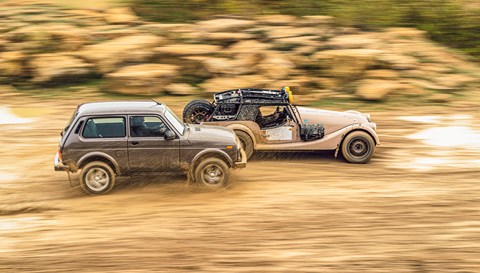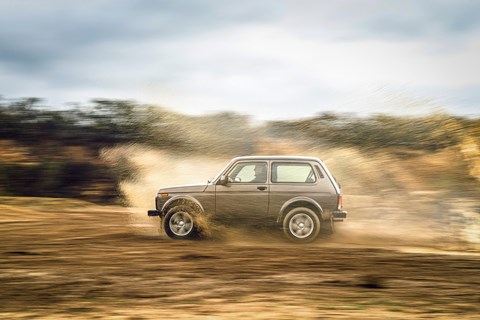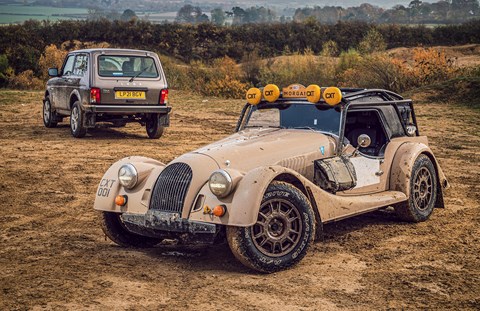► Morgan CX-T vs Lada Niva
► Back-to-basics off-roaders review
► One costs £20k, the other £200k!
The editor rings me up. ‘We’re doing a story,’ he says. ‘It’s about old relics that still have some life in them yet, ha ha! We thought you’d be perfect for it!’ ‘Ha ha!’ I reply. ‘Sounds great!’ Then a pause. ‘Ben, why did you think I’d be perfect? Ben? Ben?’Click-brrrrrrrr.
The Lada Niva has been in continual production since 1977, making it the oldest new car still on sale today. And the Morgan Plus Four? Well, depends how accurate you want to be. As a basic concept, the ‘+4’ has been on sale since 1950, though Morgan would stress today’s ‘Plus Four’ was re-invented in 2020 with an aluminium chassis. Maybe… but with its ash timber frame and flowing sports car looks, there’s no denying its ancient DNA.
Normally these two cars would occupy very different pages in CAR: a road test of the new Morgan, perhaps; while the poor Lada would no doubt be the butt of some cruel joke. Example: a man goes into an accessory shop and says to the assistant, ‘Can I have a hubcap for my Lada?’ The shop assistant thinks for a moment and then replies, ‘Seems like a fair swap.’
But to see these two cars side by side? Well, these two brands are brought together today because of extraordinary twists in their tales – two unexpected turns that share a common narrative quality: they’re both weird.
Our guide to the best 4x4s

So let’s start with the Lada. You can still buy these new? Yes, you can. Weird. Lada entered the UK in 1974, selling what was essentially a Russian-built Fiat 124 saloon, assembled on the banks of the Volga under licence. At first these were admired as robust economy cars, built for the Siberian winter and perfectly at home in miserable, clapped-out ’70s Britain. But by the ’90s, models like the Riva and Samara had become ancient old tat and the Lada brand was ruined. UK imports ceased in 1997.
But there was always one Lada that stood out. For some reason the Niva 4×4 not only avoided joke status, it developed something of a cult following as a crude-but-capable off-roader. That’s partly because it was actually quite advanced when it came out. Developed by Lada’s Soviet parent, AvtoVAZ, the Niva (which means ‘wheat field’) was inspired by the new, emerging breed of passenger-car 4x4s like the Range Rover and Mercedes Geländewagen. When it went into production in 1977, the Niva became the world’s first unibody SUV (it’s a monocoque, not a ladder frame) and it featured a tough little 1.6 four-cylinder engine, permanent four-wheel drive, high and low ratios and a lockable centre diff. Amazingly, it had a solid axle at the back but independent wishbones at the front, with coil springs all round – this at a time when the Series 3 Land Rover was still using horse-cart leaf springs.
Lada Niva: Brutalist styling meets back-to-basics engineering
The other reason the Niva always held its head high was the styling – that kind of minimalist, almost Brutalist simplicity you see in Fiats of the ’70s. Its boxy volume, sliced-off tail and sharp, utilitarian lines gave it the same kind of perky attitude as the original Giugiaro-penned Panda of 1980.
It’s the Niva’s cult appeal that brings us here today. Back in 2010 a chap called Mark Key, a graphic designer by trade, saw a Niva doing some icy 4×4 duties in a ski resort and recalled how cool they’d been when still on sale in the UK. To cut a long story short, Mark was inspired to privately import one from a Russian agent (a process he modestly describes as ‘quite challenging’). He then sold this car on, thus starting what would become a wholly unexpected Niva import business.

His steady trickle of cars came to a halt in 2016, when the still-in-production Lada finally fell foul of advancing EU regulations; but then (trumpet fanfare) Brexit came along and saved the day. Mark explains: ‘Suddenly we [the UK] weren’t so bothered about all those type approval e-marks, and everyone became a more relaxed about Nivas coming in again.’
So Mark is importing once more on a private basis, and the car you see here is a 2021 Niva Legend, 44 years young, available brand new from £19,595. Not only that, this really is the last time you’re going to be able to buy one fresh from the factory, because Lada’s new parent company, Renault, will finally give this old workhorse the bullet in 2023 (paving the way for an all-new Niva, as previewed by a concept car revealed last winter).
The cheapest electric cars you can buy
‘The Lada Niva is tiny, so simple, all glass up top and spindly tyres’
So what does a 1977 car feel like in 2022? It stands out in a modern car park just by being so tiny, so simple, all glass up top and spindly tyres, exposed axles and fresh air from the bumpers down. In classic style there are two keys: a small one for the ignition, a doll’s-house key for the doors. The interior (and these new imports are all left-hand drive) is surprisingly modern, like a ’90s Dacia! The Niva interior recently got a bit of an update, with better ventilation, firmer seats, a few Renault switches and two Decadent Western Capitalist cupholders.
Mechanically the car remains unchanged: the engine in now 1.7 litres and 82bhp (though it’s still related to the Fiat 124 unit of 1966). The gearbox is five-speed and there have been some refinement improvements over the years, but essentially it’s the same car. The example you see here is the Luxe model (£20,395 on the road) which adds alloys, electric windows, tinted glass and air-con, though personally I’d prefer the standard car with its steel wheels and stark purity. The combination of alloy wheels and drum brakes on the Luxe is like ordering pineapple on a pizza.

The Niva’s engine starts with an agricultural honesty and we pull away. The steering wheel is bewilderingly big and the gearchange probably has the longest reach I’ve ever experienced: putting it in fifth is like stretching over to get a bag of toffees out of the glovebox. But it’s a car that engages you, demands your attention – your hands and feet are constantly on the move if you want to make smooth progress, and I like that. Building up speed slowly (0-62mph takes… yawn… a full 17 seconds) we settle at a comfortable 55mph.
Push harder (top speed: 88mph) and the engine starts groaning and the transmission starts whining and the whole thing feels like too much hard work. So I ease back to 55… and relax. Even the ride is okay at that speed – it’s not a Range Rover, but it’s no horse-cart either. I wouldn’t want to drive 300 miles, but for a quick trip to the shops there’s a cheeky pleasure in it.
A quick trip to the shops, or… maybe a visit to the local quarry? To meet the other car in this unlikely duo.
Introducing the Morgan Plus Four CX-T
So, I was talking about things taking an unexpected turn, right? Meet the Morgan CX-T. It’s based on the Plus Four, with its 255bhp BMW 2.0-litre four-cylinder turbo engine and Morgan’s CX bonded aluminium chassis. Morgan will tell you the T stands for ‘trials’ and will spin some story about a three-wheeler doing an event back in 1740; but in reality, this car taps into the adventure zeitgeist that’s already spawned the likes of the Ariel Nomad and Singer ACS.
It looks like the unholy love-child of Chitty Chitty Bang Bang and a radio-controlled Tamiya beach buggy.
CAR magazine lives with an Ariel Nomad

I ask Morgan’s James Lewis-Barned how the hell a car like this ever gets off the ground. He assures me it’s not down to any market segmentation or customer analysis: ‘Our designers are always sketching all sorts of weird and wonderful things,’ he says. ‘They pin them on the walls as inspiration, like private mood boards of ideas. Our CEO Steve Morris saw this one and just said, “Let’s do it”.’
So they did. Morgan teamed up with RallyRaid UK, a race shop in Huddersfield that builds and enters cars and bikes in the Dakar. It brought proper competition thinking to the project: so the bars you see aren’t the true rollcage (that’s under the hardtop); instead, the exoskeleton is an equipment rack for a toolbox, luggage cases, fuel cans and spare wheels. Despite the familiar styling, most of this car is new: there’s a bespoke, side-exiting exhaust; a full-length underbody protection tray; the bonnet is raised slightly for better cooling and to get the electronics higher in the car; and that saddlebag on the driver’s side actually holds the repositioned air intake. Under the skin, the revised suspension features modified Plus Six wishbones and competition-spec springs and dampers from rally specialists EXE-TC.
Morgan CX-T price, specs and why on Earth they decided to build it
All this attention to detail, Morgan tells us, justifies the eye-watering £204,000 price – cough, splutter. Yes, you can buy 10 Nivas for the price of one CX-T. Only, you can’t buy a CX-T actually, because Morgan is only building eight examples and they’re all sold. So the price is both preposterous… and perfectly reasonable.
But is it all show, all this high-end mechanical fiddling? After all, the CX-T – crucially – remains rear-wheel drive, and despite those Dakar-style wheels and tyres, it still looks like it’s going to get beached on the first obstacle. There’s only one way to find out.

Jumping from the Niva into the Morgan is like getting out of an old person’s armchair and lying down on the ground. Looking at the cabin I’m convinced I’m never going to fit, but I’m soon reminded that this CX chassis is more Mazda MX-5 than vintage MGA when it comes to ergonomics, and it’s actually surprisingly roomy inside. With the windows off, those low-cut doors leave you feeling very exposed. I look down at the claggy brown clay – within touching distance – and realise this is going to get messy.
As well as the engine, the CX-T also gets BMW’s xDrive rear diff with three settings: fully open, fully locked and a limited-slip middle way. Set to halfway-house drift mode, I head off into the quarry to have some fun. What becomes immediately clear is that the CX-T is a beautifully balanced car: just fling it in – plenty of bite from those front tyres – then jab the throttle and the tail swings round in an easy, mud-splashing arc. With the long, louvred bonnet ahead and my seat on the rear axle, the slide is progressive and easy to catch, even on this slick mud, and the combination of precise steering and responsive engine allows you to eke out a gravelly drift like a ’70s Ford Escort rally driver.
The aluminium chassis feels reassuringly rigid: yes, the ride is jiggly, but given how a normal Plus Four jolts over a pothole, it’s incredible how this car can round off such jagged off-road bumps. Filled with confidence, I venture into the rougher stuff, to see how far I can go before I get it stuck.

Turns out the CX-T doesn’t want to get stuck. It’s the old Renault 4 maxim, that light weight, decent torque and excellent wheel articulation will get you anywhere, even without four-wheel drive. Can you believe the Morgan has similar ground clearance to a Land Rover Defender (see panel below)? I know, it’s like an optical illusion. And while the fat tyres look jammed tight into those arches with no room for movement, in fact the suspension has quite a bit of compression and seemingly endless ‘droop’. Climbing diagonally over a hard rock edge, the front wheel lifts off, but as the car overbalances and comes down on the nose, the rear suspension somehow dangles down the rear wheel like a baby giraffe’s hind leg, keeping the tyres in contact with the ground and ensuring you still have drive.
On steep, wet surfaces too, the Morgan refuses to get stuck. I discover by locking the rear diff and giving it some welly, it’ll bolt up practically any steep, rocky gully. It’s mad: I thought the CX-T would need winching out in minutes – now I’m thinking it could be a real Dakar contender.
What are they like off-road?
Unlike the Morgan, the Niva is a proper 4×4. With the centre diff locked and the box in low range, it has the advantage of being able to crawl up inclines, rather than needing a run-up like the CX-T. At just 2.2 metres, the Lada’s short wheelbase helps too: while the CX-T is all about showboating around like some eccentrically British Ken Block Gymkhana film, the humble Niva can explore tighter tracks at the margins of the quarry.
We venture down these little side trails, between the trees and thick with mud, and the Niva just grinds away, relentlessly turning those wheels and moving forwards. Like the Morgan, the Lada benefits from light weight – at 1285kg it’s almost a tonne lighter than the new Defender 90 – and the veteran 1.7 four-pot is so torquey, the Niva will start pulling uphill from barely more than tickover. Like the Morgan, the wheels never seem to lose touch with the ground, no matter what crazy angle you’re at, and suddenly that big steering wheel is great for windmilling around as you weave and squirm your way up a track. No wonder farmers and hardcore off-roaders still admire the Niva – the basic ingredients remain right; touchscreens and Bluetooth connections mean nothing when all you need is traction.

Verdict
So, amazingly these two cars have more in common than you might think: yes, they’re both relics – but they’re not done yet. They’re both good off-road, the Niva having more depth than the Morgan, but the CX-T is surprisingly capable. They’re both quite expensive for what they are, though Mark Key – like Morgan – doesn’t seem to have any problems finding Niva customers. Over the course of 2021 he imported a few dozen cars.
And the other quality they share is bags and bags of character – the kind that makes enthusiasts like us fall for stupid cars we don’t need. I’d love to drive the CX-T across the Australian Outback or on the gravel pistes of North Africa; and the Niva strikes me as a car that would be good in a nuclear apocalypse. Be in no doubt, it would survive.
More comparison tests by CAR magazine